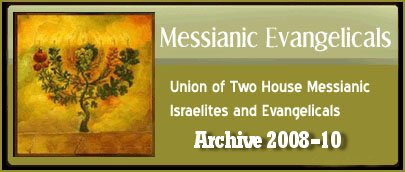RESOURCES
5-144000
A
B
C
D
E
F
G
H
I
J
K
L
M
N
O
P
Q
R
S
T
U
V
W
Y
Z
|
|

|
Tzav “Command” - Vayikra (Leviticus) 6:1- 8:36
Posted by Lev/Christopher on March 31, 2009 at 9:20am
in Torah Studies
10 Nisan 5769 - April 4, 2009
When the Cohen HaGadol sinned, he could not officiate at the altar. As a result, the Children of Yisrael would not have an intermediary to place their sacrifices on the altar. Vayikra 4:3 makes it clear that when this happened, the entire nation shared in the guilt. An unclean Cohen HaGadol brought guilt on the entire nation. Therefore, consecration of the Cohen HaGadol was essential to the welfare of the entire nation. However, an unclean Cohen HaGadol could not officiate at the altar. As a result, the Cohen HaGadol could not officiate at the altar to atone for his own sin. To prevent this situation HaShem provided an intermediary who could officiate at the altar when the Cohen HaGadol could not. An intermediary worthy of atoning for the High Priest required a greater anointing than a priest. The one individual in Yisrael that had a greater anointing was Moshe. In fact, his anointing was so exulted that he spoke to HaShem face to face as Shemot 33:11 states “the LORD spoke unto Moses face to face, as a man speaks to his friend.” Moshe's face-to-face contact with HaShem gave him a state holiness that kept him constantly in the Lords presence. Moshe's level of holiness was so great that he was even considered to be like god to the High Priest. In fact, the translation of Shemot 4:16 from The Complete Jewish Bible, states, “for you he will be a mouth; and for him, you will be like God”. Through Moshe, it was possible for the High Priest to become clean, and return to his duties in the Tabernacle. In Tzav, we can see how Moshe anointed and sacrificed for Aharon and his sons so that they could begin their duties in the Tabernacle.
As part of HaShem's requirements of sanctification, He commanded Moshe to wash, clothe, and anoint the cohenim. The first part of the cohenim's sanctification required an outward change. The first step required the cohen to bathe. Vayikra 8:6 states “Moses brought Aaron and his sons, and washed them with water”. Washing the High Priest prepared him to wear the holy garments. The second step in the cleansing process was for the High Priest to be clothed with the Holy garments.
Vayikra 8:7-9 states “he put upon him the coat, and girded him with the girdle, and clothed him with the robe, and put the ephod upon him, and he girded him with the curious girdle of the ephod, and bound it unto him therewith. And he put the breastplate upon him: also he put in the breastplate the Urim and the Thummim. And he put the mitre upon his head; also upon the mitre, even upon his forefront, did he put the golden plate, the holy crown; as the LORD commanded Moses.” Wearing the holy garments represented that the High Priest was to remain holy. The holy garments of the High Priest symbolized HaShem's Holiness in the midst of uncleanness. The final step required Aharon to be anointed with the fragreant annointing oil and the blood of the sacrifice. Vayikra 8:30 states “And Moses taketh of the anointing oil, and of the blood which is on the altar, and sprinkleth on Aaron, on his garments, and on his sons, and on the garments of his sons with him, and he sanctifieth Aaron, his garments, and his sons, and the garments of his sons with him.” The anointing of the High Priest allowed him to receive the same fragrant oil that anointed the Tabernacle. In other words, the High Priest became a vessel of the Tabernacle. This process of change was required by HaShem so that everyone in Yisrael could witness the transformation of the priest from unclean to holy. As a result, the outward sanctification of Aaron and his sons became a testimony for Yisrael of the transforming nature of HaShem.
However the outward appearance of Arron and his sons is not the only transformation HaShem wanted to occur. HaShem wanted Aaron's inner holiness to match his outward appearance. For the spiritual cleansing sacrificial offerings were required. The first sacrifice required for the sanctification of the High Priest was the sin offering. Vayikra 8:14 states “He brought the bullock for the sin offering: and Aaron and his sons laid their hands upon the head of the bullock for the sin offering.” Unlike the sin offering mentioned in Vayikra 4, this sin offering was not slain by the person bringing the offering. In this instance, the Moshe killed the offering for Aaron and his sons. Moshe was the only individual in Yisrael that was greater in authority than the High Priest. Therefore, Moshe was the only individual worthy to sanctify the High Priest through the process of sacrifice.
The second step in the spiritual cleansing of the Cohen HaGadol was the blood commitment. Vayikra 8:23-24 states “Moses took of the blood of it, and put it upon the tip of Aaron's right ear, and upon the thumb of his right hand, and upon the great toe of his right foot. And he brought Aaron's sons, and Moses put of the blood upon the tip of their right ear, and upon the thumbs of their right hands, and upon the great toes of their right feet: and Moses sprinkled the blood upon the altar round about.” When the blood was placed on the right ear, right hand, and right toe of Aharon and his sons they entered a covenant with HaShem that required them to dedicate their lives hearing, doing, and walking in HaShem's will. Therefore, placing the blood on Aharon and his sons symbolized their commitment to serve HaShem with their heart, soul, and strength. Aharon and his sons then presented a wave offering from the ram of sanctification. This was done to symbolize the gratefulness of Aharon and his sons because HaShem had sanctified them in flesh and in spirit. Finally, to show Yisrael their lives were totally dedicated to HaShem. Aharon and his sons were required to sit in the presence of HaShem, and not leave the tabernacle for seven days. At the end of seven days, they were sanctified and were allowed to leave the Tabernacle. When they left the tabernacle on the eighth day Aharon and his sons had been transformed in flesh and in spirit and were now acceptable priests.
Because an unclean High Priest brought guilt into the whole congregation, the sanctification of the High Priest was a crucial part of worship at the tabernacle. However, to sanctify the High Priest required an individual with a greater anointing than the High Priest. Therefore, HaShem chose Moshe as a vessel worthy of sanctifying Aaron and his sons. To sanctify the Aaron and his sons Moshe bathed them, clothed them, anointed them and sacrificed for them. At the end of the sanctification process Aaron and his sons were worthy to hear, do and walk in HaShem's will and serve Him with their heart, soul, and strength. When Aharon and his sons completed the entire process, they represented HaShem's desire for every individual in Yisrael to be physically as well as spiritually sanctified.
http://www.about-torah.org/
Rabbi Yaakov benYosef - ABOUT Torah
-
Reply by Christian on March 31, 2009 at 2:08pm
-
-
-
Reply by Lev/Christopher on April 1, 2009 at 5:34am
-
-
|


This page was created on 5 May 2010
Updated on 5 May 2010
Copyright © 1987-2010 NCCG - All Rights Reserved
|
|


